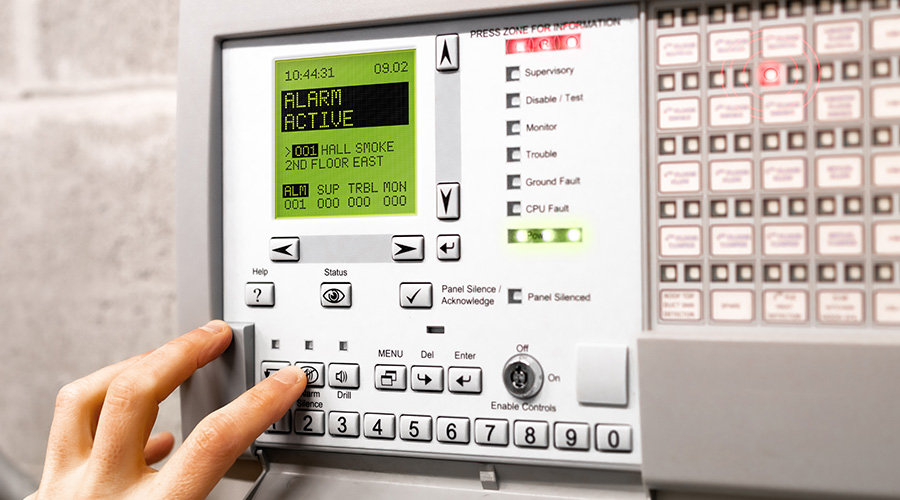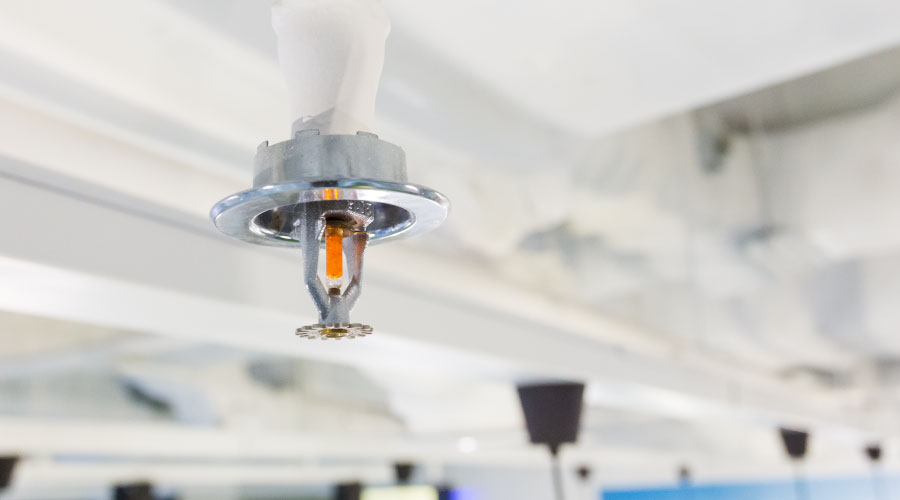Light to the End of the Tunnel
Code changes, new laws and better technology have accelerated the adoption of photoluminescent systems.
Photoluminescent emergency marking systems have been used for years on planes, trains and ships to assist evacuations, particularly when power is out. Today, the systems are being adopted more widely by facilities to help guide occupants in emergencies when there is little or no light.
Photoluminescent marking systems are not intended to illuminate a space or an egress path. Rather, they glow in the dark to define a space or path so occupants can orient themselves and identify a safe route that avoids all obstacles.
The components require no electricity since they absorb energy from ambient light and re-emit it when the light is out. The performance of a photoluminescent component is measured primarily by brightness and the amount of time it produces light. Performance in an application depends on several factors, including the pigment concentration, the intensity of light used to charge the pigment, how long the pigment is charged and the type of light used to charge the pigment. Fully charged, most pigments produce light at least eight hours, with the light level slowly decreasing. The first 90 minutes is the most critical time in a building evacuation.
Photoluminescent signs and markers are fully automatic in operation and require little maintenance. They require no electricity, other than to power the ambient light sources used to recharge them. They do not deteriorate from use and are nontoxic and non-radioactive.
The aesthetic impact of photoluminescent markings should be carefully considered.
In December of 2000, a change was made to the NFPA 101 Life Safety Code that introduced criteria for using photoluminescent exit signs mounted above doors. The change specifically allowed use in locations where the sign was exposed to a minimum light level during all times the building was occupied. This code change was critical in opening the door to the broader use of photoluminescent signs and materials in buildings. For the first time, building owners had the option of using photoluminescent exit signs instead of electric signs. Some owners now use photoluminescent informational signs even when there is no requirement for them.
In July of 2001, Underwriters Laboratories published UL Standard 924 Supplement, Photoluminescent Exit Signs. This standard set performance, durability and legibility requirements any photoluminescent exit sign must meet.
The real push for photoluminescent technology has come from New York City. One of the recommendations of the city’s World Trade Center Code Task Force was to require installation of photoluminescent signs on doors leading to exits and markings in all exit stairs. Their recommendation was based in part on failure of the emergency generator powering the emergency lighting circuit following the 1993 bombing of the World Trade Center.
A New Standard
As a result of the findings of the task force, New York City passed Local Law 26 in 2004. The law requires installation of photoluminescent emergency markings in any office building more than 75 feet in height, regardless of age. Part of Local Law 26 establishes the technical standard, RS 6-1, for installation of the photoluminescent signs and markings to be in compliance with the law. The standard identifies the minimum requirements for low-level photoluminescent markings to aiding build evacuations. The standard requires photoluminescent markings on:
- All exit doors
- All doors that lead to corridors that serve as exit passageways
- The entire horizontal leading edge or side markings of all steps
- The entire leading edge of all landings
- The entire length of all handrails (in new buildings)
- The entire length of all building egress paths
- Edge markings for any obstacle that projects more than four inches into an egress path
- Direction signs that point towards the means of egress.
In addition, “not an exit” signs must be posted over dead ends in a building.
Similar legislation is now under consideration in other jurisdictions, including New Jersey and Chicago. Pathway marking was also required in California following the MGM Grand fire in Las Vegas in 1985. Also, NFPA 101 required pathway marking in special amusement buildings after a fire at an amusement park in New Jersey in 1984.
Answering Questions
Despite the code changes in New York, some have raised questions about whether the products will work as they are supposed to. Will they be bright enough to guide occupants out of a dark building? Occupants moving from a fully lit area to one where the only illumination is provided by photoluminescent materials may require a few seconds to acclimate to the new light levels. Will that delay evacuation? Perhaps the most significant questions involve the fact that light output steadily declines as stored energy is emitted. This concern is addressed by testing the luminance of the systems at the end of the emergency period, 90 minutes in the case of exit signs. If the luminance of signs and marking is satisfactory at the end of the emergency period, they will be even more visible earlier in the emergency.
Photoluminescent performance has been examined in several studies. Interviews with people evacuated during building fires showed evacuations would be safer and quicker if more egress guidance information was available. Emergency lights and exit signs offered the best solution but did not always perform as expected in emergencies.
Researchers in the United Kingdom performed a series of tests where evacuation rates were timed under a wide range of conditions. They found that evacuation times for areas with photoluminescent systems were comparable to those with conventional emergency lighting systems.
Other researchers who examined evacuation times under dense smoke conditions found that photoluminescent systems actually improved evacuation times.
While the materials are low or no maintenance, several issues must be considered for systems to function properly. To be effective, the material must be continually illuminated at a level sufficient to fully charge the pigments. Light levels must be measured prior to installation to ensure that they meet the requirements of the component manufacturer. It is also important to consider what happens if the lights are automatically switched off after hours. Facility executives should determine how long it takes pigments to charge fully when lights are turned on the next day and should consider what will happen if an emergency occurs during that time.
Environmental conditions must also be considered. Although pigments do not deteriorate with time as long as they are not exposed to direct sunlight, dust and dirt on the surface of the sign or marking will affect both the rate of absorption and the level of light released. So while the materials may require no maintenance, regular cleaning may be required to keep them functioning properly.
Photoluminescent Product Choices
Although photoluminescent materials are available in a wide range of formats, two are most common: peel-and-stick components and rigid signs and markers. Peel-and-stick materials can be applied to concrete and wood floors, wallboard, equipment and furnishings. They are commonly used to mark a path of egress and to identify obstacles within that path. There have been reports of adhesion issues in some peel-and-stick installations in New York City.
Rigid signs and markers are typically mounted on walls, doors and building columns. They include direction signs that point towards exit doors and emergency evacuation areas and floor plans with evacuation routes. They can also be used to identify the location of emergency equipment — such as fire extinguishers, fire hoses and communication equipment — and to mark dangerous areas.
To define evacuation routes, facility executives should use continuous wall strips. Photoluminescent tape can also define the edges of equipment and other items that pose a hazard to occupants following the egress routes.
Signs and photoluminescent tape can be used to identify exits and the location of fire extinguishers, fire hoses, alarm pull stations, emergency telephones and first-aid stations. Photoluminescent signs can also label doors that lead to dead ends within the building.
— James Piper, Contributing Editor
|
Inside Photoluminescent Technology
Today’s photoluminescent emergency marking systems use rare earth mineral crystals that absorb and store energy from ambient light. Materials with photoluminescent properties, such as zinc sulfide crystals, have been in widespread use for more than 50 years. Unfortunately, these materials have limited brightness and illumination duration times, restricting their use primarily to toys and novelties.
In 1995, a new photoluminescent material, strontium oxide aluminate, became commercially available. It offered a brightness level that is roughly 10 times greater and lasts 10 times longer than what could be achieved with other photoluminescent materials. Essentially a pigment, it can be contained in a wide range of materials, including ceramics, plastics, tape and paint. It can be charged with light produced by a wide range of sources, including incandescent, fluorescent and halogen lamps. While it can also be charged by sunlight, exposure of the material to direct sunlight will cause performance to deteriorate.
— James Piper, Contributing Editor
|
James Piper, Ph.D, PE, is a writer and consultant who has more than 25 years of experience in facilities management. He is a contributing editor for Building Operating Management.
Related Topics:











